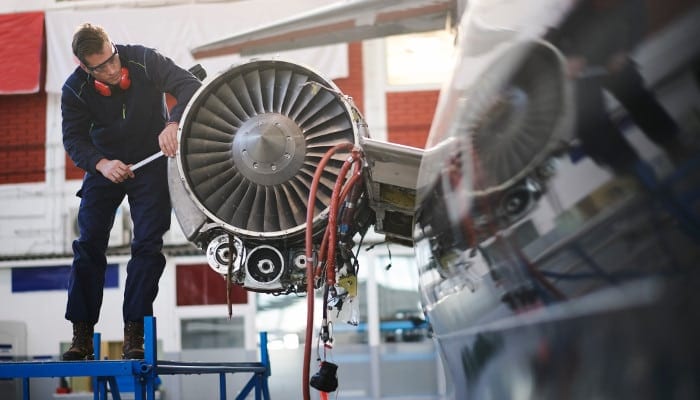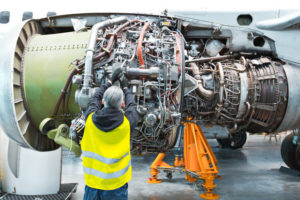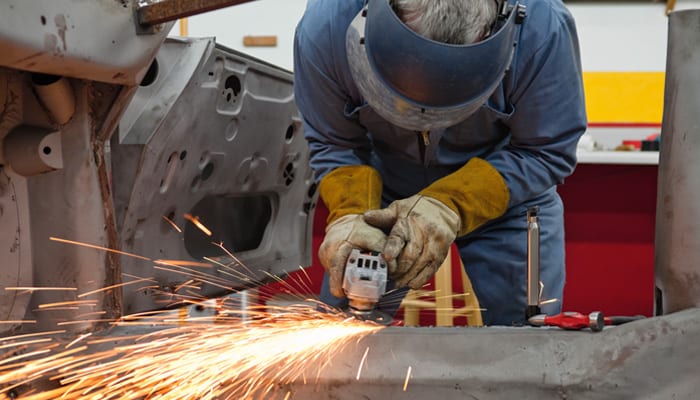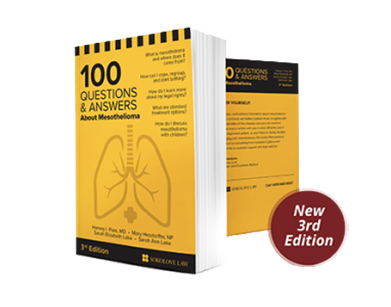Aircraft Mechanics & Asbestos Exposure Risks
Aircraft mechanics maintain and repair a wide variety of military, commercial, and private aircraft — including helicopters, airplanes, and jets — to keep passengers and pilots alike safe.
 In the process, they may have been exposed to asbestos. This strong mineral, used for its fire and temperature-resistant qualities, is now known to cause cancer in humans.
In the process, they may have been exposed to asbestos. This strong mineral, used for its fire and temperature-resistant qualities, is now known to cause cancer in humans.
As a result, many mechanics are just now being diagnosed even though they were exposed years ago. Unfortunately, asbestos-related diseases can be scary, confusing, and costly for aircraft mechanics and their loved ones.
As aircraft mechanics worked on various parts, asbestos materials could be disturbed, causing small fibers to crumble and release into the air. Exposure to these fibers may cause humans to suffer from diseases like lung cancer or mesothelioma. It takes decades for these diseases to develop.
By working with an asbestos law firm like Sokolove Law, compensation to pay for treatments and other expenses may be within reach.
Billions Recovered Nationwide
At Sokolove Law, we’ve recovered over $5.1 Billion for thousands of mesothelioma patients and their families nationwide. Let us get you the results you deserve.
Mesothelioma
Aircraft mechanics, particularly mechanics who served in the U.S. Air Force or U.S. Navy, may be at an increased risk of mesothelioma due to occupational asbestos exposure.
Exposure to asbestos is the main cause of mesothelioma, which is an aggressive cancer that impacts the thin lining of organs such as the lungs, heart, and abdomen.
Symptoms of mesothelioma include:
- Chest pain
- Chronic cough
- Shortness of breath
- Vomiting and nausea
- Weight loss
If you are experiencing these symptoms and believe you have been exposed to asbestos, contact your doctor as soon as possible. Early detection of mesothelioma is crucial to improving mesothelioma life expectancy.
Lung Cancer
Tobacco smoke is not the only cause of lung cancer. Many people may not know that asbestos exposure may increase an aircraft mechanic’s risks of developing lung cancer.
Asbestos lung cancer is different than mesothelioma because the cancerous tumors develop inside the lungs rather than in the thin lining surrounding the lungs.
Lung cancer symptoms include:
- Chest pain
- Fatigue
- Persistent cough
- Shortness of breath
Even if you smoked cigarettes and were later diagnosed with asbestos-related lung cancer, you may still be eligible for compensation. Call (800) 647-3434 now to learn more.
Asbestosis
Asbestosis is a noncancerous chronic illness that affects the lungs. When aircraft mechanics worked closely with asbestos products in aircraft parts, they likely inhaled asbestos fibers.
These fibers remain in the lungs for years, causing irritation or other damage. This impacts the lung function and can lead to fluid build up in the lungs and other deadly symptoms.
Asbestosis symptoms include:
- Chest pain
- Loss of appetite leading to weight loss
- Shortness of breath
While not cancerous, asbestosis can lead to even more harmful illnesses like mesothelioma and even heart failure.
If you are experiencing these symptoms, contact your doctor immediately to work through diagnosis and potential treatment options.
Diagnosed with an Asbestos-Related Disease?
Sokolove Law can fight for financial compensation on your behalf to help pay for medical costs and other expenses.
A History of Asbestos in Aircraft
Throughout the 20th century, aircraft mechanics came into contact with asbestos in almost every part of an aircraft. Due to the high amount of asbestos-containing parts in aircraft at the time, mechanics were exposed nearly every day to the dangerous mineral.
Asbestos was favored for its fireproof and sound-reducing qualities, both of which were vital for military usage as well as commercial and private aircrafts. Asbestos was also very lightweight and a natural insulator due to its fibrous makeup.
Asbestos continued to be used by the government, military, and private sector through the 1980s. Eventually, the Environmental Protection Agency (EPA) issued widespread limits on asbestos due to its dangerous properties. However, thousands of mechanics had already been exposed.
Sadly, many companies that manufactured asbestos-containing products knew that their goods could cause serious health issues. These companies ignored the potential health risks, so they could make more money.
Though asbestos was phased out of U.S. airplane parts in the 1980s, some imported parts still contain asbestos. Museum-bound planes or still-flying aircraft built during the asbestos boom may also have asbestos-containing materials still intact. Those who work on these aircraft may be put risk.
What Aircraft Parts Contained Asbestos?
 While asbestos was used in many different aircraft parts, it was most often used in brake linings, pads, and shoes. Brakes were subject to high heat and friction, and asbestos helped prevent them from wearing out.
While asbestos was used in many different aircraft parts, it was most often used in brake linings, pads, and shoes. Brakes were subject to high heat and friction, and asbestos helped prevent them from wearing out.
Asbestos particles — loosened by friction — would accumulate in aircraft brake housings. When the housings were opened, the particles would enter into the air. Research studies indicate mechanics who repaired brakes in aircraft faced a higher level of asbestos exposure.
Other aircraft parts that commonly used asbestos include:
- Clutches
- Electric systems
- Engines
- Gaskets, control valves, and grommets for engines
- Glue, adhesives, and other sealants
- Insulation for engine and exhaust systems
- Heat shields, heat blankets, and heating systems
- Hydraulic service lines
When these asbestos-based parts would deteriorate, they released small amounts of asbestos fibers. Aircraft mechanics were then exposed to these fibers as they removed the parts. Mechanics could also leave the worksite covered in asbestos dust.
By bringing the toxic dust home with them, they may have unknowingly exposed their loved ones to asbestos as well, which is known as secondhand asbestos exposure.
Learn More About Asbestos Exposure & Mesothelioma
Aircraft Worker Roles at Risk of Mesothelioma
Aircraft mechanics were not the only ones put in danger from asbestos. Thousands of people who worked, designed, and maintained aircraft and their parts ran a risk of exposure.
Other people at risk from asbestos exposure due to aircraft parts include:
- Aerospace Engineers: These engineers were tasked with creating, designing, and maintaining aircraft. Engineers who worked directly on site could have been exposed to asbestos fibers or dust.
- Factory Workers: Those who worked on assembly lines or factories where aircraft parts were made were regularly exposed to asbestos-containing materials. None of them realized that asbestos could be deadly.
- Family Members: Family members of aircraft mechanics were at risk of secondhand asbestos exposure. Asbestos fibers and dust could stick to the clothes, hair, and skin of aircraft mechanics. These fibers could become airborne when workers returned home.
Financial Help for Aircraft Mechanics and Their Families
Despite asbestos regulations and safety guidelines, aircraft mechanics today could still be at risk. Since symptoms may not develop until 20-50 years after exposure, a grim diagnosis could be around the corner for many.
Treatments for these illnesses may help extend the life of those affected. However, they can also be costly or even out of reach for many families.
Financial compensation may be available through:
- Mesothelioma lawsuits filed against the makers of asbestos-containing products you were exposed to
- Asbestos trust fund claims against bankrupt companies that manufactured or sold asbestos products
- VA benefits for veterans diagnosed with mesothelioma or other asbestos-related diseases
This compensation can help pay for medical expenses and protect your family’s future.
At Sokolove Law, our mesothelioma lawyers can help you understand your legal options. With over 45 years of experience in the industry, you can trust our commitment to finding justice for mesothelioma patients.
Contact us today for a free legal case review to see if you may be eligible for compensation.
Aircraft Mechanic Asbestos Exposure FAQs
What are the symptoms of asbestos exposure?
Symptoms of asbestos exposure may vary for each person and for different asbestos-related diseases. Symptoms may also resemble those of the common cold or seasonal flu.
Common symptoms from asbestos exposure include:
- Chest pain
- Persistent cough
- Unexplained weight loss
If you believe you were exposed to asbestos and are experiencing these symptoms, contact your doctor immediately to begin screening options.
How long does it take for symptoms of asbestos-related illnesses to become present?
Asbestos fibers can remain in the body for years, slowly causing damage without you realizing. In fact, many symptoms of mesothelioma and other asbestos-related illnesses may not become present until 20-50 years after initial exposure.
Aircraft mechanics who worked on parts prior to the 1980s should be mindful of potential symptoms and talk with their doctor regularly. Detecting asbestos-related illnesses earlier is critical in providing treatment.
How much does mesothelioma or asbestos lung cancer treatment cost?
Treatment for mesothelioma or lung cancer caused by asbestos can quickly exceed $400,000. That is why Sokolove Law has been committed to supporting victims of asbestos exposure for more than 45 years.
Manufacturers of asbestos products knew of the dangers of the material and continued to put millions of innocent people at risk of deadly illnesses.
Sokolove Law has recovered over $9.6 Billion to help support those impacted by asbestos-related illnesses. Contact us today at (800) 647-3434 to get the help you deserve.



